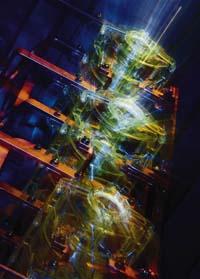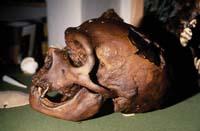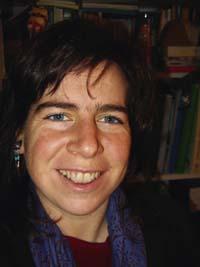Text written in Basque and translated automatically by
Elia without any subsequent editing.
SEE ORIGINAL
Fraud Science
2006/01/01
Kortabarria Olabarria, Beñardo - Elhuyar Zientzia
Iturria:
Elhuyar aldizkaria
Scientists are honest people who, working and researching, seek to obtain discoveries that serve the development of society, answering the questions that human beings have asked and that they do. They are able to give up everything, including basic physical and psychological needs. This kind of belief is widespread in society, but woe! News Belief is half corrupt; the scientist is a normal, virtuous and defective person who can fall into the clutches of fraud.
Fraud Science
01/01/2006 | Kortabarria Olabarria, Beñardo | Elhuyar Zientzia Komunikazioa

(Photo: siemens)
7,000 American scientists recently received an unnamed survey. They were asked if they had ever performed an unacceptable attitude or action. 3,000 of the 7,000 surveys received by respondents. The result was as follows: 1.5% acknowledged having ever falsified data or plagiarism. It is not so much, and from there it can be deduced, well thought out, that scientists are quite honest. But there is more data, 33% of scientists acknowledged that they committed worse misdeeds: 15.5%, unable to withstand the pressure of the sponsors, adapted the methodology or results of the investigation; 12.5% accepted erroneous data from others; and 7.6% recognized more fellows, such as the unauthorized use of ideas from others or the use for the benefit of confidential information.
Several examples
It is difficult to determine when fraud begins in science. Think, it is not easy to determine when science itself begins. For setting a date, XVII. The 20th century can be considered the starting point of modern science, when the methods of inductive reasoning were introduced. Until then, speculation was more science than science. However, there were no great revolutions either. XIX. Until the middle of the 20th century science had great technological limitations and had not many possibilities of trials. Revolution XIX. It happened in the last years of the century, when trial assessments and data-based reports became methods. If fraud is rejection of the scientific method, it seems appropriate that date, but it is logical to think that it already existed before.

Scammers also outperform the strictest controls.
E. carton
From then until today the examples are abundant, some of them truly famous in their time and in the following years until becoming theoretical lines. This happened last year with the German anthropologist Reiner Prosch. Reiner Protsch was known for having discovered the skull of a 36,000-year-old human around Hamburg. In the 1980s this news shocked anthropologists around the world, convinced that they were in the eyes of the union between modern man and Neanderthal.
Protsch claimed that for thousands of years the man of Neanderthal, a neighbor of Europe, and the newly arrived Homo sapiens of Africa, lived together at some point. Moreover, between them they had descendants. It is now discovered that the 36,000 year old skull discovered by Protsch was only 7,000 years old. The committee investigating the fraud has claimed that Protsch had never conducted carbon 14 dating tests and had repeatedly presented false fossils with the sole intention of achieving world fame. It will partly fulfill its dream, it will enter the history of anthropology, but by fraud.

Fraud does not seem difficult, but many technical details must be taken into account.
CP
The discovery of German fulfilled the theory of the missing link, that is, it proposed another step in the theory of human evolution. Although much of the scientific community did not recognize it, the theory put on the table a novel contribution. And now, when it is proven to be a fraud, it turns the link theory upside down
its scope and all subsequent work. It will be necessary to review these works to see to what extent this theory conditioned.
However, the most striking fraud in anthropology is that of the man of Piltdown, a fraud on account of Darwin's theory of evolution. In 1912, in the Geological Society of London, paleontologists Charles Dawson and Smith Woodward presented a great discovery: the missing link between monkey and man, the skull of an unknown species until then. The fraud lasted 45 years. In 1953 it was discovered that the skeleton was made with human bones and animals. The work had to be excellent, as during the time mentioned experts from around the world investigated the discovery of the village of Piltdown.
Of course, the sciences that investigate the past are not the only ones that have fallen into fraud. All sciences have a hidden history. In physics, for example, the prediction of cold fusion was very popular. In 1990, two US researchers, Stanley Pons and Martin Fleischmann, declared finding a cheap and clean nuclear power production system: cold fusion. Faced with the fear of losing the advantages of the fatherhood of the invention, they did not publish any article.

The sciences that investigate the past are not the only ones that have fallen into fraud. All sciences have a hidden history.
archive
Later it was known that the journal
Nature had denied the publication of the article before its announcement because "there was not enough data about the sessions". The results of these sessions have never been replicated in laboratories.
But do not think that the control systems of prestigious journals always work. On more than one occasion they have deceived prestigious journals such as Nature, The Lancet, PNAS, Science and, of course, others less prestigious. Physicist Jan Hendrik may be the most prominent, since in the aforementioned publication he published more than 80 articles, many of them with false data. The name of the British researcher Andred Wakefield also became known when he published an article in The Lancet that showed that the MMR vaccine – against measles, breeding and rubella – could cause autism. The fraud in this case had direct consequences.
Following the publication of the article in The Lancet, the authors of the alleged study held a public press conference in which the topic had a great impact on the media. As a result, many children have not received the vaccine and since then, measles outbreaks have taken place in Britain several times. The fraud was serious, as scammers received money for fraud. It seems that the intention of the fraudsters was to denounce the laboratories producing the vaccine and take money from them. Apparently, the control of larger journals is not as rigorous as expected.

The thymus of cold fusion to capture the energy of the stars was recognized.
walk
Fraud anywhere
Another characteristic of fraud would be the lack of citizenship. Grab the ball of the world, start spinning and place your finger at any point. Explore the history of local science and discover fraud, also in Euskal Herria. Perhaps the most prestigious is that of prehistoric paintings.
In 1991, a student named Serafin Ruiz discovered a painting in the cave of Zubialde in Gorbeia. He looked little, made spectacular paintings (20 figures and 50 rare signs) and announced his discovery. The work was brilliant, it seemed to the real eye, but finding traces of esparto in the exams they knew that the author of the paintings was Serafín himself. Although experts asked for discretion in the face of the discoveries, then politicians spread the news to the four winds.
By the thread of the story, fraud can be considered a situation or event of the past, but it is not so. Scientists who manage to clone man, the discovery that will reveal the origin of life, cancer vaccines or miraculous treatments, the vital traces found on other planets, the discoveries of new chemical elements, etc. are things that can be read, heard or seen almost daily. In some way, they are facts that respond to what we human beings want to hear and what we expect. Fortunately, scientists who work honestly on that path are more than fraudsters. News
Regulations
What is fraud in science?
Fraud goes beyond the scientific method. As for theoretical and empirical scientific results, it has been defined as an intention to deceive the scientific community. But behaviors related to unhonest attitudes are taken into account. The following types of fraud are distinguished:
Manufacturing: report the results of unperformed studies.
Counterfeiting: deliberate alteration of data.
Plagiarism: presentation of the work done by another.
Theft: appropriation of the idea, project or result of another.
Data handling: if it is taken into account not to cite data that could imply changes in the results.
Errors in data collection: do not search the literature, do not take into account background, work with few data, do not contrast data...
The lack of reference to the work done prior to the presentation of the study.
When publishing them, include authors who are not really authors, for their fame or in return to appear as authors in their work, publish them in several places...
Inflation: introduction of false data in the curriculum.
Aizpea Leizaola: "The frauds that have revealed science are the healthiest"
Before accepting the discoveries, articles are published in magazines, they pass through the hands of experts... how can fraud occur?
As it is increasingly published, it is increasingly difficult to pass everything through sieve. Over the past 30-50 years, the proliferation of scientific publications has somehow made this guarantee reach all areas. In fact, there are magazines that have prestige for that, because they have to pass more than one sieve. On the other hand, in these cases, the prestige of the experts comes into play. The expert becomes authority, which he says is almost undeniable and not questioned. This also helps fraud advance.
Why cheat?
More than for money, I would say for prestige. In Japan there is a prestigious archaeologist, named Fujimori, who received the pseudonym The Hands of God for his special discoveries. When he was a victim of swindle, he confesses that he did it for prestige, so that his name would be known in the scientific community and passed on to history.
There are other frauds that try to highlight the science itself. I would say they are the healthiest, because they push science itself to ask questions and make us think about how easy it can be to fix scientific truth, absolute truth.

(Photo: F. leizaola)
There are many frauds, but to name a few, the attention of Nacirema.
The American anthropologist Horace Miner wrote in 1956 an article in the most prestigious anthropological magazine in the country. He cited the Nacirema tribe, located in North America. He described the violent rites and practices they had with their body, the degree of dissatisfaction with their body, the degree of punishment of their body. He commented that in all the families there was a small altar with babies of magical characteristics. She described women's problems with her chest. In this article, a detailed X-ray of the vision of the Nacirema tribe had of their body was made.
The article caused scandal: Who were these Births? Where did they come from? How did the anthropologist work? Carefully reading the work shows that the author wanted to make a satire. If the word Nacirema is read against, American appears. So he made a portrait of American society and ridiculed it.
Another striking case is the Piltdown man.
It is the longest lasting among those known so far. It lasted sixty years. Think that in 1908 the first traces appeared, were made known in 1912 and a public fraud was committed in 1952. And those in it still do not know who committed the fraud.
Was it a great job?

Those of Nacirema look very closely at their appearance.
(Photo: archive)
When fraud occurs, there are two parts: on the one hand, why fraud works and, on the other, what the scammer uses to occur.
It is also important how fraud is technically conducted. In the case of Piltdown, the fraudster fully took into account the technical knowledge of the time: what dating techniques there were, what criteria were used to identify the materials... he went very carefully, the bones of the cheeks were raised, so that the parts were matched and disappeared... And an archaeologist made the discovery public, but it was discovered by some quarry workers. Therefore, there is anonymity; we do not know for sure whether they were buried by this archaeologist, by workers or by others... All this has not been known until now and the safest will not be known until a time passes.
There are frauds that can cover the gaps in theories of a given time. They are the most likely to work. However, they are also the ones that most suspicions can generate: "Is it so simple? Can a simple discovery fulfill what had been left at the hypothesis level for so many years?" we can think.
And what can be done to prevent fraud?
It is impossible to avoid it. They have always been and will continue to exist. This is related, on the one hand, to the current weight of science, to the importance that society gives to science. And that shows us, to some extent, why it seems interesting that people are deceived, why it is worth deceiving that science that builds absolute truth. And on the other hand, to a certain extent, when a fraud is evidenced, which forces to review what was done until then. That, in itself, is not bad.
At time intervals some scientific fraud is known. Aizpea Leizaola, professor at the UPV, is an anthropologist. He knows something about the influence of fraud both in anthropology and in the rest of science.
Kortabarria Olabarria, Beñardo
Services
216
2006
1.
040
Evolution; Physics; Energy; Ethics; History; Humanities; Medicine; Others











